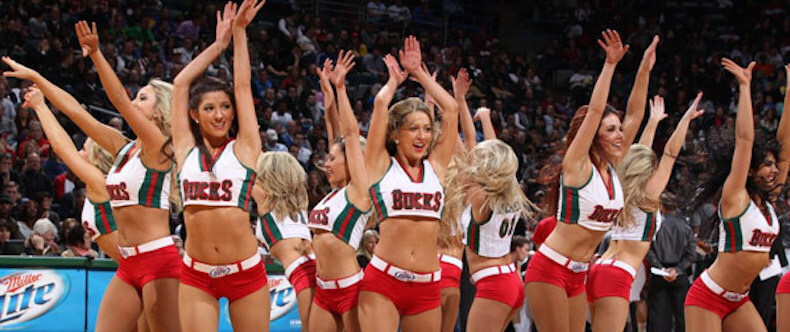

All the Rage
Underpaid Labor Is Nothing to Cheer About
Major sports cheerleading teams are getting a raw-rah deal, as last week's Milwaukee Bucks lawsuit shows. Will they find a place in the “laborers of love” revolt?
This article was made possible because of the generous support of DAME members. We urgently need your help to keep publishing. Will you contribute just $5 a month to support our journalism?
Last week, former Milwaukee Bucks cheerleader Lauren Herington filed a federal lawsuit against the National Basketball Association team, accusing them of violating labor laws that require minimum wage and overtime. Herington became the latest major sports cheerleader to rebel against the low wages and grueling schedules demanded by the team, joining women who performed with the Oakland Raiders, Tampa Bay Buccaneers, and other National Football League teams.
Her lawyer told reporters, “They are indentured servants with pom-poms.”
For those of us who watch sports mainly on television, the cheerleaders appear only briefly, but Herington’s suit says that she worked 30 to 40 hours a week, receiving a flat fee per appearance—$65 for a game, $30 a practice, and $50 for required special appearances. They are required to arrive two and a half hours before a game, comply with strict appearance policies that necessitate out-of-pocket spending on salons and tanning, and attend “workout sessions” for 15 to 20 hours a week. When Herington worked more than 40 hours a week, she says she was not paid overtime.
“It should come as no surprise that cheerleading is hard and demanding work, both physically and emotionally,” Mary Clinton, union organizer and former NCAA Division 1 Cheerleader for the University of North Dakota Men’s Hockey team, told me. “Behind the scenes leading up to the gameday glamor are mandatory workouts, rehearsals, appearances, and choreography memorized for a perfect performance in front of thousands, perhaps millions, of fans. No pressure.”
NFL cheerleaders have been challenging similar working conditions for some years now, beginning in the 1990s when the Buffalo Jills—the Bills’ cheerleaders—briefly managed to form a union, which was crushed by management. More recently, several former Jills sued, claiming they were misclassified as independent contractors, unpaid, charged $650 for uniforms, and required to turn up for demeaning “special appearances” where they were required to dance and do backflips for wealthy sponsors. Their social media presences were monitored, to make sure they didn’t embarrass the team. They were required to visit a plastic surgeon, a team sponsor, who offered them a small discount. The New York Times‘ Michael Powell wrote of the Jills, before they soured on their work, “Nothing about local pride is phony. One hundred and fifty women paid $50 each to try out as a cheerleader, and viewed it as an honor and a thrill.” They did indeed want to do it for the love, but found out that after all, it was just a job, one that lacked even the most basic reward—a wage.
These teams are certainly not suffering for a lack of cash. The Bills, Powell noted, recently sold for $1.4 billion to a family of fracking titans. The Milwaukee Bucks sold for $550 million in 2014; in addition, the team just got $250 million in Wisconsin tax dollars for a new stadium, thanks Governor Scott Walker, the recent presidential race dropout. The team’s ownership, Jenna Johnson at the Washington Post noted, includes one of Walker’s biggest donors. (To be fair, another co-owner of the team is a bundler for Hillary Clinton.) Wisconsin has seen massive budget cuts to public services, public employees’ wages, and most recently cut $250 million from the University of Wisconsin system, but a sports stadium is top priority. Making sure the Bucks’ cheerleaders are paid fairly is clearly less of one. The plight of the cheerleaders, like that of other low-wage workers, Clinton said, comes down to power—who has it, and who doesn’t.
Labor activists, sports fans, and feminists often discount the cheerleaders’ struggles, assuming that their work is not real work, treating them as slightly embarrassing in a Lean In world. But we should all take their work, with its deeply gendered expectations, more seriously. Like women the world over, the cheerleaders put their own demands on the sideline for years, even decades, to support the men who make the millions (and the owners, who make exponentially more). Even the NFL referees, who were locked out by the owners in 2012, made $8000 a week. The details of the cheerleaders’ lawsuits are a lesson in the labor of beauty, making clear and often putting a dollar value on the time and money the cheerleaders spend to look just right. The emotional labor they do is harder to quantify, the smiles they must wear for the TV cameras and the wealthy sponsors who hand over a few bucks for the opportunity to ogle and paw, but it too is not unique to cheerleading.
When I waited tables in New Orleans, I worked with a woman who was a Saints cheerleader. The gig didn’t even pay her enough for her to give up her part-time hostess job at the restaurant during football season. The work was similar, if we did wear more clothing at the restaurant; we were expected to smile and serve and not argue much. The hostesses were, to a woman, attractive and young, even if not expected to pass a literal weight test.
My former colleague Lynn Parramore wrote in 2013, “Cheerleading is an example of a tournament-style job market in which intense competition reigns and a few lucky winners get the spoils. If you’re a fiction writer, for example, maybe you’ll write the next Da Vinci Code. Or maybe you’ll endure horrible contracts and struggle to pay the rent. If you’re a cheerleader, maybe you’ll end up with a plumb television assignment. Or perhaps you’ll hurt your knee and spend the rest of your life paying for the injury because you don’t have insurance.”
The cheerleaders are one part of what I’m beginning to think of as the “revolt of the laborers-of-love,” the pushback by workers who have been told that their job is so glamorous, so special, possessing such vast potential for future fame and wealth that they should do it for nothing, or for next to nothing. The cheerleaders are in line with the unpaid interns on films like Darren Aronofsky’s Black Swan, the NCAA athletes at Northwestern who demanded to be allowed to form a union, and even the wave of unionization rippling through the media world in recent months and years, a wave I was part of in 2014 as a staff writer at In These Times. They are insisting that what they do is, in fact, work, not a spangled hobby that they do for love of the team, the film, the writing.
The spread of this revolt to NBA cheerleaders is a good sign for all, even if it is mostly taking place in the realm of individual lawsuits for now. That could change–this month, in response to the Jills’ lawsuit, legislators in New York introduced the Cheerleaders’ Fair Pay Act, which would require teams to treat cheerleaders as employees, eligible for minimum wage and overtime protections, and to form a union. Changing their conditions over the long term, Clinton reminded us, requires collective action.
Before you go, we hope you’ll consider supporting DAME’s journalism.
Today, just tiny number of corporations and billionaire owners are in control the news we watch and read. That influence shapes our culture and our understanding of the world. But at DAME, we serve as a counterbalance by doing things differently. We’re reader funded, which means our only agenda is to serve our readers. No both sides, no false equivalencies, no billionaire interests. Just our mission to publish the information and reporting that help you navigate the most complex issues we face.
But to keep publishing, stay independent and paywall free for all, we urgently need more support. During our Spring Membership drive, we hope you’ll join the community helping to build a more equitable media landscape with a monthly membership of just $5.00 per month or one-time gift in any amount.




















































































